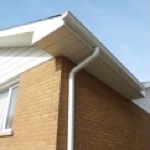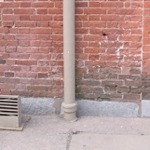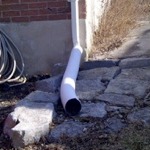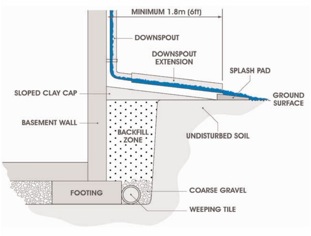
What are downspouts?
Downspouts are the pipes that take the collected roof runoff in your eavestroughs down to the ground. When it rains, or when the snow on your roof melts, the downspout allows for the collection and drainage of your roof by allowing it to flow down to ground level. They are also referred to as “roof leaders”.
What is the problem with downspouts?

Downspouts themselves aren’t the problem. They are required to properly drain the runoff from your roof. The problem can be where this water gets discharged to.
If the downspouts come down your exterior walls and enter a pipe in the ground, they are most likely going to the sanitary sewer.
Considering that a single home is able to drain quite a bit of water during an intense rainfall, imagine if many homes were doing the same thing, at the same time. This quick and sudden rush of water into the sanitary sewer can rapidly over-fill the pipes and cause sewage backups in basements. Roof runoff is relatively clean storm water which should not be directed into the sanitary sewer system. Your home may not be experiencing flooding as a result, but you may be contributing to sewage backups of a neighbour or someone even further away.

Sanitary sewers are not designed for storm water, and overloading the sanitary system not only causes sewage backups into basements, but also causes bypasses of untreated sewage to the environment – your local rivers and lakes.
If not to the Sanitary Sewer, where should downspouts discharge?
In general, it is best practice to discharge your downspouts to your own lawn so that the water can naturally infiltrate into the ground. If you are unable to do that for legitimate technical or safety reasons, your next alternative is the storm sewer. Discharging to the sanitary sewer is not an acceptable alternative as you put not only your own home at risk, but also the homes of others at risk of sewage backup. You may need to touch base with the City’s Engineering Department to assist you in finding a suitable discharge location for your storm water. It’s worth noting that there is no “grand-fathering” or acceptance of older downspouts going into the sanitary sewer. Just because it used to be done that way, doesn’t mean it’s right.

What does the City plan to do about downspouts?
Downspouts are located on private property and generally, the maintenance, upkeep and discharge is up to the homeowner. But, discharge of downspouts to the sanitary sewer system can affect everyone, including your friends and neighbours, and the environment. For this reason, the City of Kingston has made downspout discharge to the sanitary sewer illegal, by way of By-law 2008-192 (Clause 3.11). The City will soon begin enforcing disconnection of downspouts from the sanitary system.
What should I do?
Be a good neighbour, and disconnect your downspouts. We all need to work together to reduce basement flooding!
-
Disconnection of downspouts is relatively easy, in most cases and is well within reach of the average Do-It-Yourself’er with some basic tools and tool know-how. It involves cutting the downspout about 30-45 cm above the ground (depending on how far out you want to go with it), and installing an elbow and pipe extension to divert the water to the surface away from the house. You should strive to get the end of the extension 2 metres away from your foundation.

An ideal downspout configuration (courtesy ICLR, 2009)
Better yet, install a rain barrel as well to intercept some water for garden irrigation.
There are a number of online resources listed below to provide some instructions on how to do it.
In certain cases, doing some work up on your eaves troughs may be required to relocate the downspout to a more suitable location, for example a corner of the house within easy reach of a large part of lawn. Given that this involves work at height, use of a suitably qualified contractor is recommended.
Sometimes, extension of a downspout onto the lawn requires crossing a pathway, or other features. There are options such as swiveling elbows or flexible hoses that allow movement of the downspout so it is not fixed in a disruptive position at all times.
One thing you need to make sure of is that the positioning of your downspout does not put your neighbours at additional risk of flooding. While it is beneficial to try to get the drainage as far away from your own foundation as possible, make sure you don’t create new problems for your neighbours.
Some resources
- The Downspout Disconnection page at Canada Mortgage and Housing Corporation
- Here are three good resources from the City of Toronto:
-
As By-Law enforcement commences, a formal exemption process will be developed for which homeowners will need to apply. This process has not yet been developed. However, it will likely contain provisions for situations that are either technically non-feasible, or likely to create hazardous conditions.
At this time, it is recommended that residents do their best to disconnect ALL of their downspouts. If it is believed disconnection is not feasible, or would create a hazardous condition, disconnect as many as you can. An exemption may be permitted for individual downspouts as required although this will need to be approved by By-Law officers and will not be granted lightly.
Examples of reasons that may qualify for an exemption:
- There is no place to discharge downspouts other than right into neighbouring homes or right onto a public sidewalk.
Examples of reasons that will likely not qualify for an exemption:
- Conditions where re-direction of downspouts from one corner of the house to another would result in an acceptable downspout position.
-
Most homes in the City of Kingston do not have a storm sewer lateral, only a sanitary sewer lateral. In most cases therefore, if your downspout is going into the ground, it’s likely that it is going into the sanitary sewer system, illegally.
In some areas of the City, and in newer development areas, homes may be serviced by a storm lateral. However, putting your runoff drainage into the storm system also has its risks. The best practice is to discharge roof runoff to your lawn where it can infiltrate naturally.
The City and Utilities Kingston don’t always have a record of whether a home has a storm lateral or not. If you want to find out, calling Utilities Kingston is the first best bet, but some specialized testing by a qualified plumber might be required to figure it out (for example, using bucket tests, dye tests, or other techniques).
-
If you have perpetually-wet conditions, or frequent surface water pooling, you may wish to consider investigating more significant drainage options for your lot, perhaps even together with your neighbours. Some options may include surface re-grading of lots, or installation of some form of drainage system, such as a “French drain” or ditch/swale. These options are dependent on having some kind of a drainage outlet, i.e. a natural drainage channel, or a storm sewer.
Private-lot drainage is the owner’s responsibility, but in extreme cases, it may be worthwhile to touch base with the City’s Engineering Department to explore if any other solutions may be available and suitable.
-
Yes, it might. This impact can be minimized by running the downspout extensions as far away from your home as possible (2 metres away from the foundation is considered the minimum) or dispersing the water over a larger area using a flexible perforated pipe or something that can be moved around a bit. There also might be options like building a shallow ditch or swale, or slight re-grading to move the water away from your home.
You may also wish to consider an infiltration garden – a garden that promotes infiltration of water and uptake by plants. Come take a self-guided tour of the Utilities Kingston Water Conservation Garden located at 1211 John Counter Boulevard to see an example.
-
This is not an acceptable solution as your private lot drainage will create a freeze hazard in the winter and serve as a liability. This is a private storm drainage issue which you will need to address. If you or your plumber cannot find a reasonable solution, you may consider contacting the City’s Engineering Department to see if they can help you find a more suitable place for your drainage to go.